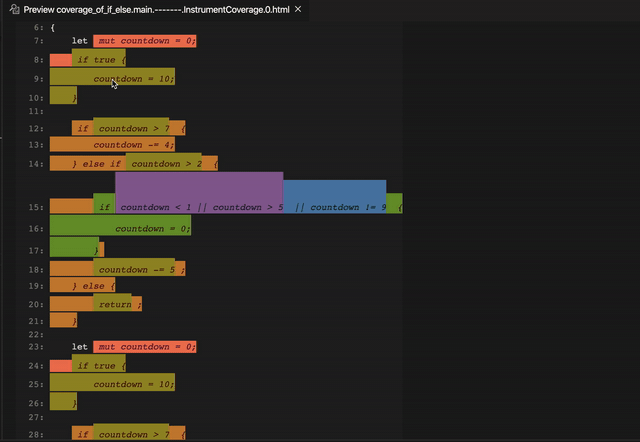Tools, tests, and experimenting with MIR-derived coverage counters
Leverages the new mir_dump output file in HTML+CSS (from #76074) to visualize coverage code regions
and the MIR features that they came from (including overlapping spans).
See example below.
The `run-make-fulldeps/instrument-coverage` test has been refactored to maximize test coverage and reduce code duplication. The new tests support testing with and without `-Clink-dead-code`, so Rust coverage can be tested on MSVC (which, currently, only works with `link-dead-code` _disabled_).
New tests validate coverage region generation and coverage reports with multiple counters per function. Starting with a simple `if-else` branch tests, coverage tests for each additional syntax type can be added by simply dropping in a new Rust sample program.
Includes a basic, MIR-block-based implementation of coverage injection,
available via `-Zexperimental-coverage`. This implementation has known
flaws and omissions, but is simple enough to validate the new tools and
tests.
The existing `-Zinstrument-coverage` option currently enables
function-level coverage only, which at least appears to generate
accurate coverage reports at that level.
Experimental coverage is not accurate at this time. When branch coverage
works as intended, the `-Zexperimental-coverage` option should be
removed.
This PR replaces the bulk of PR #75828, with the remaining parts of
that PR distributed among other separate and indentpent PRs.
This PR depends on two of those other PRs: #76002, #76003 and #76074
Rust compiler MCP rust-lang/compiler-team#278
Relevant issue: #34701 - Implement support for LLVMs code coverage
instrumentation

r? @tmandry
FYI: @wesleywiser
Adds a new mir_dump output file in HTML/CSS to visualize code regions
and the MIR features that they came from (including overlapping spans).
See example below:
Includes a basic, MIR-block-based implementation of coverage injection,
available via `-Zexperimental-coverage`. This implementation has known
flaws and omissions, but is simple enough to validate the new tools and
tests.
The existing `-Zinstrument-coverage` option currently enables
function-level coverage only, which at least appears to generate
accurate coverage reports at that level.
Experimental coverage is not accurate at this time. When branch coverage
works as intended, the `-Zexperimental-coverage` option should be
removed.
This PR replaces the bulk of PR #75828, with the remaining parts of
that PR distributed among other separate and indentpent PRs.
This PR depends on three of those other PRs: #76000, #76002, and
Rust compiler MCP rust-lang/compiler-team#278
Relevant issue: #34701 - Implement support for LLVMs code coverage
instrumentation

If a symbol name can only be imported from one place for a type, and
as long as it was not glob-imported anywhere in the current crate, we
can trim its printed path and print only the name.
This has wide implications on error messages with types, for example,
shortening `std::vec::Vec` to just `Vec`, as long as there is no other
`Vec` importable anywhere.
This adds a new '-Z trim-diagnostic-paths=false' option to control this
feature.
On the good path, with no diagnosis printed, we should try to avoid
issuing this query, so we need to prevent trimmed_def_paths query on
several cases.
This change also relies on a previous commit that differentiates
between `Debug` and `Display` on various rustc types, where the latter
is trimmed and presented to the user and the former is not.
The first use case of this detection of regression for trimmed paths
computation, that is in the case of rustc, which should be computed only
in case of errors or warnings.
Our current user of this method is deeply nested, being a side effect
from `Display` formatting on lots of rustc types. So taking only the
caller to the error message is not enough - we should collect the
traceback instead.
Similar to `-Z dump-mir-graphviz`, this adds the option to write
HTML+CSS files that allow users to analyze the spans associated with MIR
elements (by individual statement, just terminator, or overall basic
block).
This PR was split out from PR #76004, and exposes an API for spanview
HTML+CSS files that is also used to analyze code regions chosen for
coverage instrumentation (in a follow-on PR).
Rust compiler MCP rust-lang/compiler-team#278
Relevant issue: #34701 - Implement support for LLVMs code coverage
instrumentation
Fix `-Z instrument-coverage` on MSVC
Found that `-C link-dead-code` (which was enabled automatically
under `-Z instrument-coverage`) was causing the linking error that
resulted in segmentation faults in coverage instrumented binaries. Link
dead code is now disabled under MSVC, allowing `-Z instrument-coverage`
to be enabled under MSVC for the first time.
More details are included in Issue #76038 .
Note this PR makes it possible to support `Z instrument-coverage` but
does not enable instrument coverage for MSVC in existing tests. It will be
enabled in another PR to follow this one (both PRs coming from original
PR #75828).
r? @tmandry
FYI: @wesleywiser
Found that -C link-dead-code (which was enabled automatically
under -Z instrument-coverage) was causing the linking error that
resulted in segmentation faults in coverage instrumented binaries. Link
dead code is now disabled under MSVC, allowing `-Z instrument-coverage`
to be enabled under MSVC for the first time.
More details are included in Issue #76038.
(This PR was broken out from PR #75828)
Fixes#75050
Previously, we would unconditionally suppress the panic hook during
proc-macro execution. This commit adds a new flag
-Z proc-macro-backtrace, which allows running the panic hook for
easier debugging.